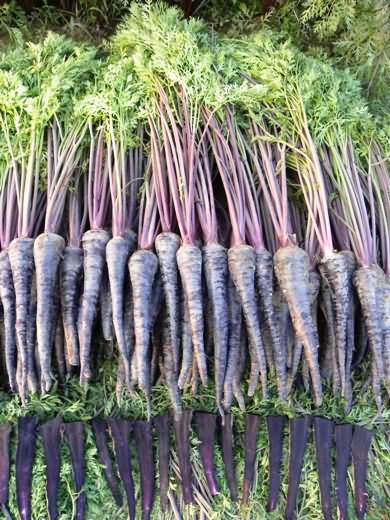उष्णकटिबंधीय गाजर की गुणवत्ता बीज उत्पादन तकनीक
Carrot has high yield per given area with less input and labour requirement. It has different colours such as red, orange and yellow colour for food plate and rich in antioxidants (carotene, lycopene, anthocyanin).
Carrot seeds demand
Globally, it is the 10th top vegetable crops in the world with annual world production. In India, carrot is cultivated in almost 22 states in India in 62,412 ha area with production of 10,73,711 MT and average productivity of 17.2 MT/ha.
The increasing trend in carrot production in country requires support to strengthen indigenous seed production of carrot which will generate employment in rural areas as well as save a huge amount of money paid as cost of seed import. However, it needs technical knowledge or training for better quality seed production.
After getting commercial crop of carrot roots, the selected roots can be planted in separate field for seed production. This gives additional advantage to carrot growers because carrot seed has huge demand in country.
Carrot has two types viz., (i) tropical carrot type which produce seeds profusely in plains during winter season while (ii) European carrots require low temperature (5-8 °C for 40-60 days before flowering), hence produce seeds in hills and not in plains.
Tropical carrots fit well for seed production in plains while European carrot produce seeds in hills.
Floral biology of Carrot
- Carrot is a cross-pollinated crop. It needs honey bees to visit flowers to ensure pollination.
- There is a primary umbel (only one) which is appears on main stalk. Then, there are secondary umbels (many) appears on secondary branches, from these secondary branches, appears tertiary branches which give tertiary umbels.
- Primary umbel is big in size and has maximum number of flowers (usually over 1000).
- The first, second, and other order umbels usually flower at an interval of 8-12 days from each other and anthesis in a single umbel is completed in 7-9 days.
- In carrot, cytoplasmic male sterile (CMS) lines are available which are required for hybrid seed production.
Umbels of male fertile line Cytoplasmic male sterile (CMS) line
Prominent varieties and hybrids
Select varieties having most demand in seed market. Important varieties/hybrids from public sector like ICAR-IARI, New Delhi are given hereunder:
Tropical carrot:
These varieties have soft textured roots with big core, well adapted to warm growing conditions and annual in nature. They have tendency for early flowering, and bolts (appearance of flowering stalk) in plains in winter season. They produce seeds freely in plains of India.
The most commonly grown and popular varieties of tropical carrots are given below:
Pusa Rudhira: Long, red colour roots, core also red, good for sowing in September end to November mid. Ready to harvest in 90-95 days after sowing. Roots are sweet and juice. Yield potential aroud 300 q/ha.
Pusa Rudhira Pusa Vrishti
Pusa Vrishti : Heat tolerant, light red roots, medium in length and suitable for sowing in August first week with proper moisture condition. Ready to harvest in 90 days during November first week, a time for field preparation of wheat crop. Yield potential 200 q/ha.
Pusa Asita (black): First black carrot variety, sowing time in October month and ready to harvest in 110-120 days after sowing. Root yield is around 350 q/ha.
Pusa Asita Pusa Vasuda
Pusa Vasuda: It is a cytoplasmic male sterility (CMS) based F1 Medium long, red colour roots, core also red, good for sowing in September end to November mid. Ready to harvest in 90-95 days after sowing. Yield potential aroud 350 q/ha.
Pusa Meghali: A tropical carrot variety with light orange colour roots. It is suitable for sowing during month of September end to November mid. It becomes ready for harvesting in 95-105 days. Average root yield per hectare is 250-280 q/ha.
Pusa Meghali
Seeds of these varieties can be produces in plains of India by growing root crop in winter season and subsequently selected roots/plants for seed crop.
Temperate carrot
Roots are firm textured with small core, adapted to cool growing conditions and biennial in nature for seed production. They have less tendency to bolt and require extended exposure to low temperature of 5-8 °C for 40-60 days before flowering (vernalization) to break dormancy. Do not produce seeds in plains and only produce in hilly region due to low temperature requirement
Pusa Yamdgini: It is orange coloured temperate carrot variety. It has medium long (15 cm) complete orange coloured tapering end roots. Ready to harvest in 100-120 days. Yield potential is around 250 q/ha.
Pusa Nayanjyoti: It has orange coloured roots with tapering end. It is a cytoplasmic male sterility (CMS) based F1 hybrid of temperate carrot. Its roots are orange, uniform, attractive, smooth, cylindrical, stumpy with a thin tail having small indistinct self coloured core. Ready to harvest in 75-85 days. Yield potential is around 300 - 350 q/ha.
Isolation requirements for seed crop of carrot
- For mother root production stage, maintain an isolation of 5 meters to avoid any chance of mechanical mixture at the time of sowing or harvesting. Maintain separate irrigation fields and channels.
- Carrot is cross-pollinated by insects, hence. a good nectar supply easily accessible attracts many insects.
- The seed fields must be isolated from other variety fields and fields of the same variety not conforming to varietal purity requirements of certification, by at least 1000 meters for foundation seed production, and 800 meters for certified seed production.
Seed production methods in carrot
There are two common methods for seed production in carrot namely,
1. Root to seed method: Root crop is raised in separate field with standard crop practices and subsequently the harvested roots are selected for external and internal traits for true to type and these selected roots are planted in separate field as seed crop. Generally, the root to seed method is followed quality seed production.
2. Seed to seed method : The seeds are sown and crop is raised with standard crop practices and allowed to grow upto seed crop.
1. Root-to-seed method
Root crop growing period
- Grow healthy root crop by sowing on raised beds in September – October months. Remove early bolters (if any) and diseased plants. When the roots are fully mature (90-100 days in case of tropical red and tropical orange varieties; 120 days in tropical black and temperate types), the harvest the roots and select true-to-type roots.
- Never use fresh farm yard manure or cow dung for carrot and always plough field 2-3 time in Apply 20-25 tonnes of well-rotted farmyard manure at the time of land preparation; At the time of final preparation mix in the soil 40 kg nitrogen, 50 kg phosphorus and 100 kg potash per ha as basal application.
- Undecomposed weeds, stubbles and crop-weed residues seriously affect carrot roots by resulting forked or branched roots.
- The seed takes eight to 10 days for germination. For uniform germination, the ridges should remain moist till germination takes place. Hence, the field should be irrigated just after sowing. Afterwards, when the plants are 5 to 6 cm high, thin out plants to a distance of 6 to 7 cm.
- Before planting, spray weedicide 3 litre per ha pendimethilin. Next day, transplant the stecklings in the well prepared field at a spacing of 60-75 cm x 45-60 cm, preferably on raised beds. Irrigate the field after planting of stecklings for better field establishment.
- Irrigate crop at 10-15 days interval and perform weeding at 30 and 60 days after planting.
Intercultural operation
- Irrigate at eight to ten days interval as required. Carrot is a slow-growing crop in initial stage. Spray of weedicide immediately after sowing pendimethalin @ 3 litres per hectare is good for initial weed control.
- Weeding and hoeing should frequently be done, particularly in the early stages. One earthing-up by end of September, or early October, will keep the crop clean till the close of autumn, when it is uprooted for planting.
- For seed crop, the proper spacing between roots is essential, for this, thinning should be done only between 25-30 days of sowing. Otherwise, shape of remaining roots may disturb.
Selection of roots for transplanting
- Roots are uprooted when plants have fully developed roots. The selection and rouging are to be done on the basis of foliage uniformity and root characters. First, on the basis of external characters such as skin colour, uniform in shape and size, true to type in size, surface smoothness and narrow shoulder.
- Second step is to cut the roots (3/4 in size) and select root based on internal characters such as self-core (coreless, uniform internal colour), uniform flesh colour, small core size, sweetness, juiciness and indistinct rings of core).
- The colour of flesh, colour and size of the core are the most important characters to be considered. The core should be same to colour of roots.
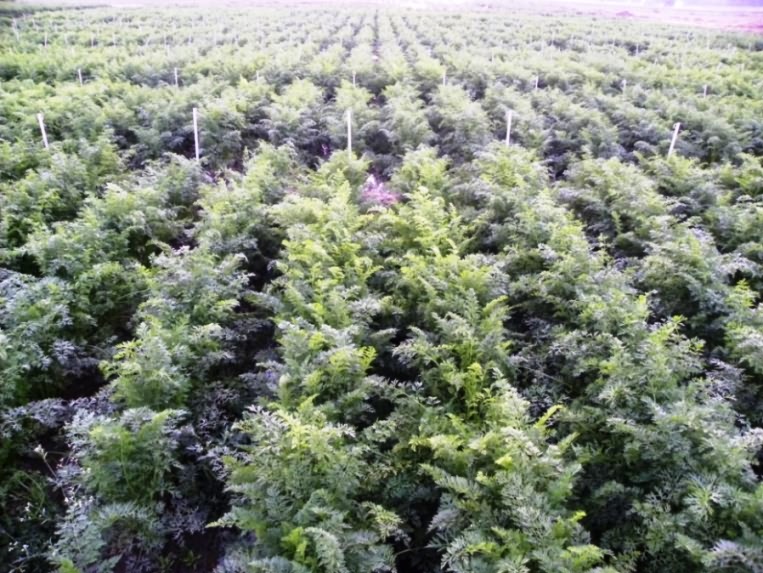
Grow healthy root crop for selection of roots to prepare stecklings
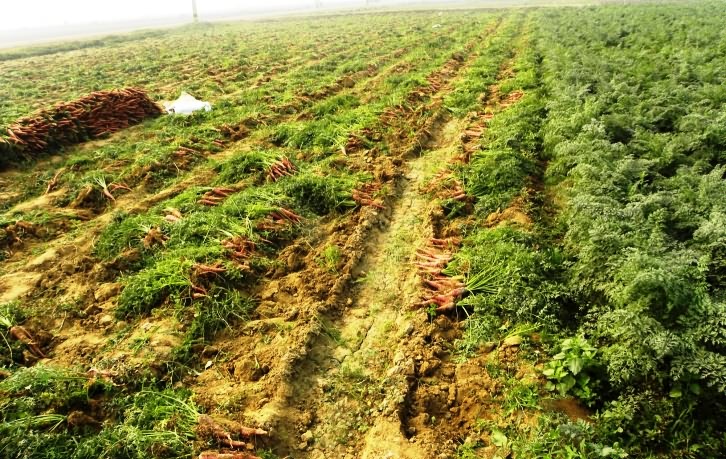
Uprooting of root crop
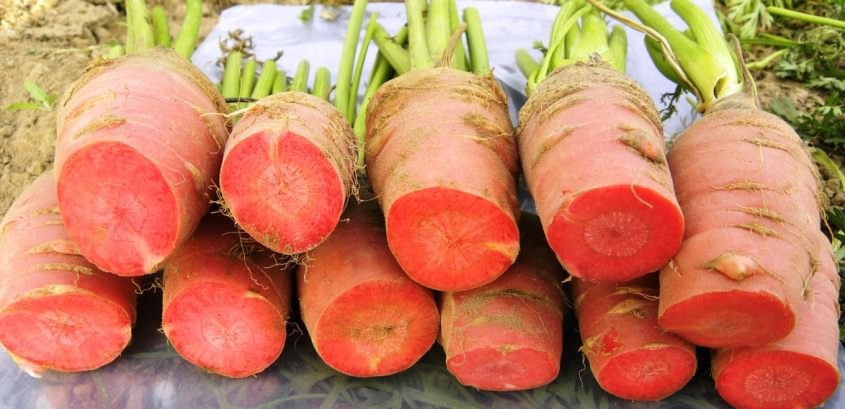
Selection of self core roots for steckling preparation
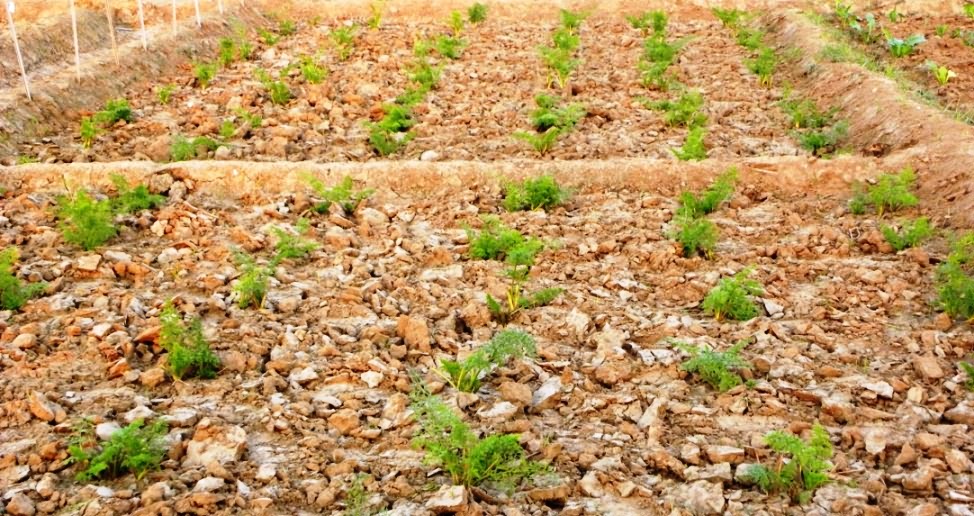
Planting the stecklings in field and and raising seed crop
After selection of true-to-type roots, cut the top portion by 5-7 cm and root portion by 5-7 cm and dip in 2% solution of bavistin or suitable fungicide.
For seed crop, prepare field by adding 10-15 tonnes of farm yard manure and ploughing 2-3 times. Apply 50 kg nitrogen, 40 kg phosphorus and 50 kg potash per ha at the time of sowing and top dress 30-40 kg nitrogen per hectare, after weeding 30-35 days after sowing.
Irrigate crop at 10-15 days interval and remove diseased and off-type plants before flowering also. Manage crop properly for diseases and pests.
Advantages
- Select on true to type roots for seed production.
- Opportunity to discard all the undesirable roots.
- Smaller land requirement for root production.
- Roots are produced in same field and only seed crop in different fields, hence reduce. Isolation duration and allow proper crop management.
- Production of high quality seed.
Disadvantage
- Requirement of extra man power at the time of selection and replanting.
Field inspection & rouging
A minimum of three inspections are required at different crop stages:
- Pre-uprooting stage.
- Uprooting and root selection stage.
- Bolting and pre-flowering stage : Early bolters and off-types should be removed.
Management of pollinators
Carrot is a cross-pollinated crop and honey-bees play crucial role in pollination. Hence, ensure proper population of honey-bees by keeping boxes or allowing their natural population to build-up. Avoid any chemical spray particularly during flowering season and especially in early to mid-day hours when honey bees are visiting the seed crop.
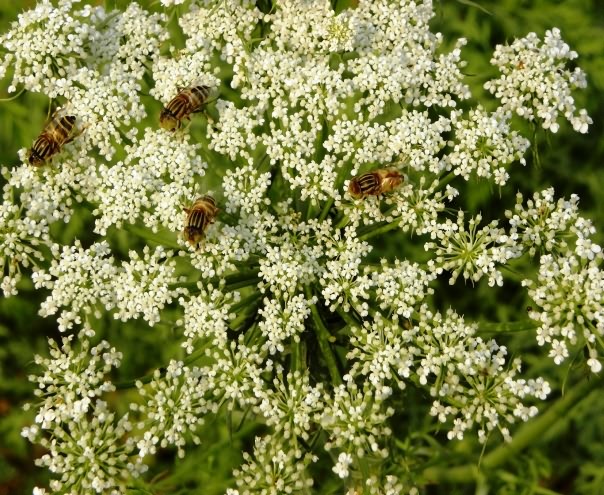
Pollinators are essential for seed production in carrot
Seed-to-seed method
The seed-to-seed method differs from root-to-seed in that the roots are allowed to remain and produce seeds in the same location where they were initially raised from seed. This method is not common in the seed trade.
For success in this method the only requirement is the sowing of seed of the highest quality to produce the roots to be left in situ. Crop management practices are same as for root to seed method except that the root uprooting is avoided here and only top dressing of fertilizers is done.
Advantages
- No extra expense on land, labour, replanting and storage of roots.
- Seed yields are generally high.
- Delayed sowing can be done.
Disadvantages
- Lack of proper roguing and selection of true to type roots.
- Uneven distribution of plants for seed.
- Quality of seed produced is not of the highest order.
The comparison between two methods is given below:
|
Particulars |
Seed-to-seed |
Root-to-seed |
|
Description |
Allowed crop to grow, overwinter and produce seed in their original position where they were sown |
True-to-type roots are selected, replanted in a separate plot for flowering and seed production |
|
Seed |
Commercial seeds (Foundation, certified seeds) |
Nucleus seeds |
|
Sowing |
Main season (October) |
September months (one month before normal season) |
|
Spacing |
45 x 10-15 cm |
45-60 x 30-45 cm |
|
Fertilizers and manures |
High dose of nutrients 50 kg N:50 kg P: 60 kg K; Additional dose of N @ 25 kg/ha at bolting and same at flowering stage |
Low dose of nutrients required as 1500- 2000 sq area is sufficient for raising roots for transplanting in one hectare area. 50 kg N :50 kg P: 60 kg K for root production 50 kg N (3 splits) :50 kg P: 50 kg K for root production |
|
Seed quality required |
High quality breeder’s seeds |
Suspected seeds |
|
Roguing staged |
(i) Rigorous at vegetative stage for uniform foliage appearance (random check of roots can be done) (ii) remove early bolter |
(i) At root harvest stage for true to type roots and (ii) flowering to remove early bolters |
|
Seed yield |
High but of genetic quality may poor |
Low but genetic quality will be high. |
Harvesting and threshing and seed yield
- The best time for harvesting is when the secondary umbels (heads) are fully ripe and tertiary heads are beginning to turn brown. The crop ripens unevenly.
- Seed is commonly harvested by handpicking. Two to three pickings may; often be necessary.
- After drying, the heads are threshed and cleaned. After cleaning, the seed is rubbed by hand to remove the bristles on the surface and graded by means of sitters and sieves. Before storage, the seed moisture content should be reduced to 8% per cent.
- The average seed yield is about 500 to 600 kg per hectare.
Factors affecting seed yield
Seed yield of carrot is determined by growth and branching of seed stalk portion. Seed stalk height and seed yield is greatly influenced by the post-vernalization temperature for examples, when post-vernalization temperature exceeding 15°/20°C (night/day) cause reduction in seed stalk growth and around 80-90% reduction in seed stalk height is observed with a post-vernalization temperature regime of 27°/32 °C (night/day).
Important diseases, pests of Carrot and their management:
|
Disease/Pest |
Damage |
Control measure |
|
|
Leaf Blight |
Seed and residue-borne. Complete loss of foliage can take place during periods of prolonged wet, humid weather. |
Seed treatment with Captan or thiram @3g/kg Spray Maneb at 7-10 days interval |
|
|
Cercospora leaf spot (Cercospora carotae) |
Both seed and residue-borne. Younger leaves are more susceptible than older leaves |
Seed treatment 0.01% mercuric chloride sol. for 5 min; dusting of Agrosan GN; Spray Zineb or Dithane Z-78 at 7-10 interval |
|
|
Watery soft rot (Sclerotenia sclerotianum) |
Roots become soft, watery, white mycelium with black sclerotia, tops of rotted carrots turn yellow and wilt as roots break down. |
Seed treatment with carbendazim @2g/kg seed or mixture of Trichoderma harzianum and T. viride based product @ 2.5kg/ha |
|
|
Aster yellow [Mycoplasma (Phytoplasma-like organism PLO)] |
Yield losses upto 10%, affected carrots have yellowing leaves and fibrous side roots. This is spread by leaf hoppers |
Spray Carbaryl and carbofuran @ 2 ml/litre of water |
|
|
Powdery mildew (Erysiphe sp.) |
Faint, slightly discoloured, tiny specks, from which white powdery spots spread to form various sized areas. |
Spray of finely powdered sulphur dust 5 sprays @ 8-10days interval with 80% Maneb 1kg/acre |
|
|
Mites |
Suck to sap and affects fruit/seed development |
Spray Omite @ 1 litre/ at 10-15 days interval. |
|
Powdery mildew in seed crop of carrot Leaf Blight of carrot in seed crop
Authors:
Shrawan Singh, Swati Saha1 and B. S. Tomar
Division of Vegetable Science, ICAR- Indian Agricultural Research Institute, New Delhi, India 110012
1IARI Regional Station, Pune, Maharashtra
Email:





